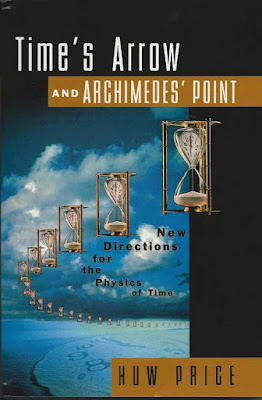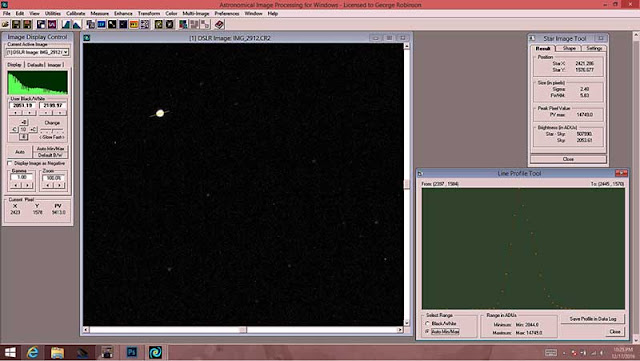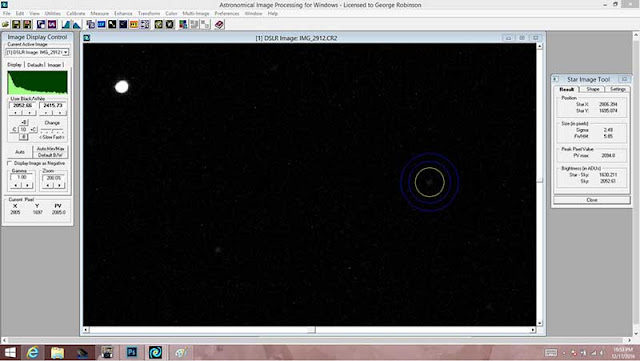This week the weather has just been terrible for most observing opportunities. The planned observing of the light curve for eclipsing binary star Algol was itself eclipsed by clouds and rain. The OCA black star canyon party was also cancelled, not because of clouds on Saturday, but
because of the very wet soaking in the canyon. But all is not lost and we have a lot to report on this week including one unscheduled observing practice session and plenty of indoor physicist wannabe activity.
So, before getting to the one Algol practice observing session, I wanted to review the direction of time controversy, the latest release of top ten fails in astronomy (mostly amateur astronomy) and the online availability of a Python programming class.
First up, remember the books I mentioned in the November 5 post that we had available on our recent Mediterranean cruise, one of which was "The physical basis of the direction of time", by Dieter Zeh. In the November 22 post, I mentioned the book that had the most pages read. Well as previously reported, I didn't make any progress on that book, but during the recent rain induced indoor activity, I had a chance to begin studying it. Well, I found it a little too difficult, essentially in its level of mathematics, so I opted to begin reading an easier book on the same topic. See the book cover below.
 |
| This book is easier and a big picture review of the direction of time controversy |
Anyway, we will see what happens in the next hundred pages. Where do you stand on this time direction issue?
I got an email from Science Squad and Gravity Guy, Ken, who forwarded another blog (hey, what are you doing reading somebody else's astronomy blog anyway?) which provided a very humorous list of the top 10 astronomy fails. Readers of this blog know full well some of the failures that happen as amateur astronomers try to improve their observing skills. I myself have personally done more than half of these fails, but these fails offer a chance at a lesson learned and an opportunity to get better. I've experienced the effect of cold on my batteries, and of screws coming loose and of typing in the wrong date and having the scope slew to below the horizon when the target is obviously high in the sky. Anyway, all amateur astronomers will recognize at least a couple of these fails. They are all funny, especially after you calm down and just enjoy the humor of the situation. Check them out at: https://thebrainbank.scienceblog.com/2016/12/12/top-ten-astronomy-fails/
Thank you for that funny reference, Ken!
The last topic for physicist wannabes is a new online course on Python programming available from UCI. I think I am going to sign up for this course. I used to do a lot of C programming over my working career and was a little disappointed that the programming community is moving away from C to newer languages like Python. Python is widely used in the astronomical community for analysis and I want to be able to understand it and maybe even do a little programming. At the same time, at various physics colloquia, I hear that even Python is being left behind for newer languages. Wow, what to do? I think I will still give it a go and try my hand at it. If anybody else is interested in courses starting up in January, then check out: https://ce.uci.edu/courses/
Finally, we can get to the latest photos and analysis gathered during the one clear evening last week. Remember that in the December 6 post, I described the recognition of a possible flaw in the observing plan. For my location in polluted city lights, I am not likely to be able to see and spot and move my camera to point at the dim Algol at magnitude 3.3. So, remember, because of this, I enlarged the camera field of view by using 150mm focal length rather than the previously set 600 mm focal length. The following photo shows the entire field of view for 150 mm telephoto lens.
 |
| Algol, brightest star near center in this frame, using 2 second exposure with 150mm telephoto The other dim stars in this view are measured to be around magnitude 6.1, much dimmer than Algol at 2.1 |
 |
| Astrometry.net screenshot showing that the camera frame does indeed include Algol near center Note the large number of NGC objects in the same field of view around Algol |
The other part of the observing plan that needed to be verified is what the proper exposure setting for 150 mm telephoto lens should be. My previous calculated estimate was that 2 seconds would be required, rather than the 1/2 second used for 600 mm lens setting. The AIP4WIN software analysis of Algol's image shows that 2 seconds is just a little bit to long. Note in the screenshot below that the light profile, along the chosen line going right through Algol, shows just one or two pixels with values of 14,749 counts. This value is just a bit too high and means the light curve measurement will be off due to the saturation at these levels. For a one second exposure, the maximum pixel count value should drop to about 1/2 that high value and this should be a good setting and even when the minima is captured there should still be enough pixel counts to get a good reading and sufficient signal to noise ratio.
 |
| AIP4WIN screenshot showing star profile and total pixel brightness for Algol |
Using the analysis tools in AIP4WIN, the dim fuzzy objects show up at about magnitude = 7.1 in the screenshot below. Note having a lot of bright objects around Algol is actually a good thing because during each eclipse, when Algol dims to 3.3, it will still be easy to identify Algol, since it will be much brighter, by a couple of magntidues, than anything else in the image, the one exception being a (assumed, based on initial measurements) magnitude 4.7 star
 |
| Expanded screenshot view of fuzzy objects just dimly visible in 2 second exposure |
So, with the December 15 eclipse date overturned by rain, the next opportunity is December 18. But now I have found a discrepancy in when the eclipse will occur. My Sky and Telescope annual paper calendar lists the eclipse minima occurring at 8:20 pm PST, and the Sky and Telescope online eclipse calculator shows the minima to occur at 7:46 pm PST. Which one is the right time? I don't know, so I fired off an email to Sky and Telescope magazine, but have not received an answer yet. Maybe, if I am able to gather some measurements and can plot the light curve we will see exactly when the eclipse is at minima. The big difference for my observing plan is that I had always been planning to do this measurement at about 11:20 pm, which was the eclipse minima on December 15. At the earlier time now, Algol will not be as high in the sky and my preferred observing location might not work. I think I will just have to move my site from the backyard patio to the front parking lot. I still prefer not to drive to some dark sky site because the total observing time is expected to cover 4-5 hours and I do prefer the comforts afforded here at the observatory.
So, based on the above findings, the revised observing plan for the next Algol eclipse is to use 1 second exposure, instead of 2 seconds. The next eclipse is for Sunday (tonight), but unfortunately the weather forecast is for mostly clear but with winds between 23-33 miles per hour with gusty wind up to 53 mph. Wow, it doesn't look too good, but I will probably take a try at it anyway. If my tripod tips over, well, I guess it was just nature's way of saying I needed a new camera (and hey, its just before Christmas, perfect timing?).
Until next time,
Resident Astronomer George
There are over 200 postings of similar topics on this blog
If you are interested in things astronomical or in astrophysics and cosmology

No comments:
Post a Comment